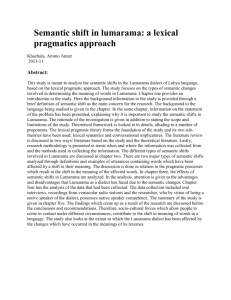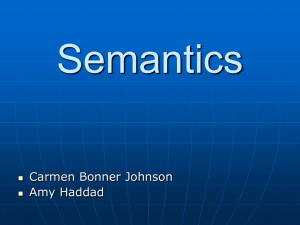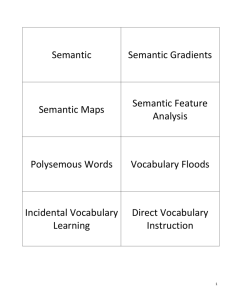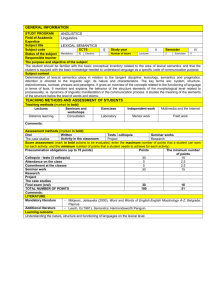Lecture 17 Notes
advertisement
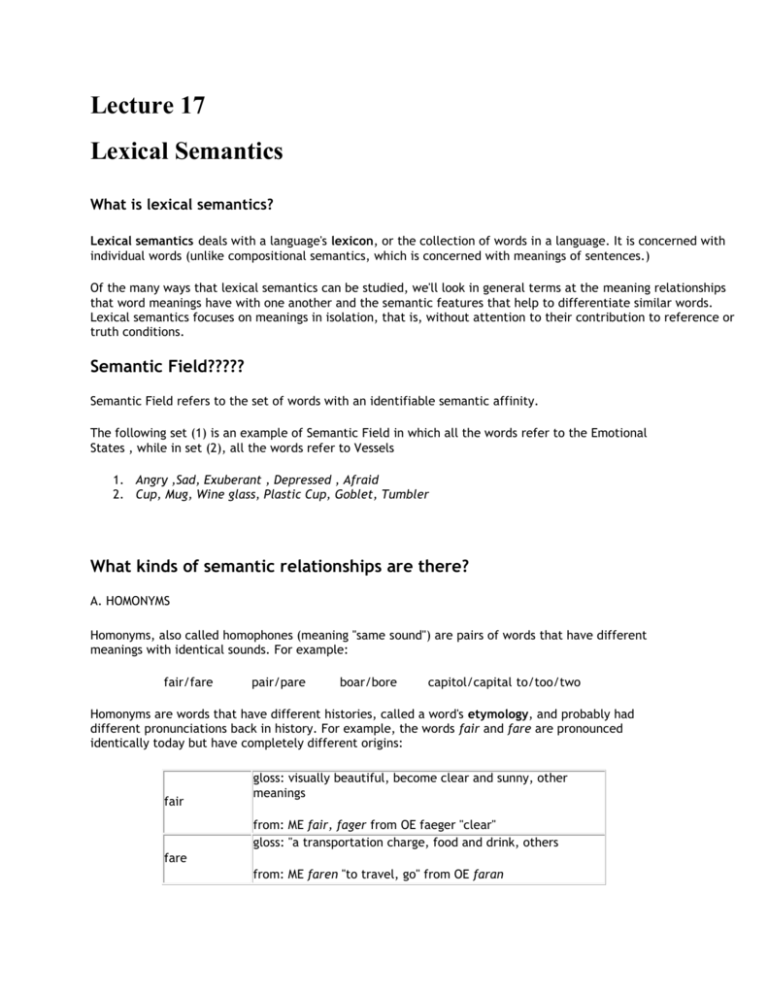
Lecture 17 Lexical Semantics What is lexical semantics? Lexical semantics deals with a language's lexicon, or the collection of words in a language. It is concerned with individual words (unlike compositional semantics, which is concerned with meanings of sentences.) Of the many ways that lexical semantics can be studied, we'll look in general terms at the meaning relationships that word meanings have with one another and the semantic features that help to differentiate similar words. Lexical semantics focuses on meanings in isolation, that is, without attention to their contribution to reference or truth conditions. Semantic Field????? Semantic Field refers to the set of words with an identifiable semantic affinity. The following set (1) is an example of Semantic Field in which all the words refer to the Emotional States , while in set (2), all the words refer to Vessels 1. Angry ,Sad, Exuberant , Depressed , Afraid 2. Cup, Mug, Wine glass, Plastic Cup, Goblet, Tumbler What kinds of semantic relationships are there? A. HOMONYMS Homonyms, also called homophones (meaning "same sound") are pairs of words that have different meanings with identical sounds. For example: fair/fare pair/pare boar/bore capitol/capital to/too/two Homonyms are words that have different histories, called a word's etymology, and probably had different pronunciations back in history. For example, the words fair and fare are pronounced identically today but have completely different origins: fair gloss: visually beautiful, become clear and sunny, other meanings from: ME fair, fager from OE faeger "clear" gloss: "a transportation charge, food and drink, others fare from: ME faren "to travel, go" from OE faran (ME = Middle English, a period from about 1066 to the 1400s) (OE = Old English, from AD 400 to 1066) Here's another example: gloss: two corresponding things designed for use together pair from: ME paire from OF from Latin paria "equal things" gloss: to trim off an outside, excess, or irregular part of pare from: ME from MF parer "to prepare or trim" from Latin parare "to prepare" (MF = Middle French, from approx. 1400 - 1611) (OF = Old French, from approx. AD 842 - 1400) By the way, the etymologies of words also help to explain spelling. For example, the silent letters k and e in the wordknife were pronounced at one point in history but were lost over time. We'll look at historical linguistics in an upcoming module. B. HYPONYMS We can say that word X is a hyponym of word Y if in all possible scenarios, X's set is always contained in (is always a subject of) Y's set. Koa, oak, and cedar as well as wood are hyponyms of tree. Consider the words poodle and dog. Suppose that the current set of poodles includes Princess. The current set of dogs will then include at least this dog and possible others as well (such as Buttercup the Rottweiler and Killer the Chihuahua.) Dog is a hyponym of animal; poodle is a hyponym of dog. animal dog poodle Princess C. SYNONYMS Two words are synonymous is they have similar meaning and are often used interchangeably. But look a little closer at common synonyms, and you'll realize that the two words aren't always 100% the same and interchangeable. 100% same quick/rapid, sick/ill, couch/sofa regional tap/faucet/spigot, skillet/pan, hot cakes/pancakes, soda/pop formality pass away/die/pop off emotion/political freedom fighter/guerrilla/terrorist legal kill/manslaughter/murder D. ANTONYMS Two words are antonymous if their meaning is opposite. There are several ways a pair of words can be opposites. Contradictory pairs are words that are nearly complete opposites -- everything is one or the other: married/unmarried visible/invisible alive/dead over/under Scalar antonyms or gradable pairs are words that are not completely polar opposites because each word has no endpoint and can very from one person to another (so, for example, hot can mean one thing to one person and something else to another person): hot/cold good/bad strong/weak happy/sad short/tall E. AMBIGUOUS Words that have double meanings are ambiguous. Many words have more than one meaning such as bank (of a river, a financial institution) and glasses (eyeglasses, sunglasses, drinking glasses.) Notice the many meanings of the wordtrunk in this cartoon F. ANOMALOUS Anomalies are nonsensical words and phrases: His cheeseburger has bad intensions and My printer doesn't like me. Semantic Analysis at word level: Three types of semantic analysis at lexical level: Words as ‘containers’ Semantic features ‘roles’ they fulfill Semantic roles ‘relationship’ with other words lexical relation Semantic Features Another way of analyzing lexical meaning is to decompose word meanings into more basic parts. This process is calledlexical decomposition. The idea is that most words have meanings that are "built up" from simpler meanings. For example, the words mare, stallion, hen, and rooster all have the common meaning of ANIMAL in them. We could say that these four words share the common semantic feature ANIMAL. In addition, mare and hen share the common feature FEMALE while stallion and rooster share MALE. Another illustration of lexical decomposition comes from causatives. Consider these pairs of sentences, which use theintransitive verbs boil, open, bake, and turn and their transitive counterparts: The The The The water boiled. door opened. cake baked. car turned. Robin boiled the water. The wind opened the door. Robin baked the cake. Robin turned the car. We can analyze the meaning of the verbs in terms of causes. In Robin boiled the water, the transitive verb boil can be analyzed as X CAUSES Y to BOIL. The late Stan Starosta at UH Manoa introduced his brand of semantic features as a series of plus or minus characteristics to compare words. Once we graduate students learned about semantic features, we began to see them in nearly every word we ever heard or read. For example, consider the difference in meaning between cement and concrete. Although many of use them interchangeably, they actually mean different things. Dr. Starosta might have explained the differences as: cement concrete + wet (or - dry) - wet (or + dry) The difference between cement and concrete is that cement is a wet while concrete is dry. There are other ways to describe the two words (cement is a mix combined with water while concrete is the hardened after-product), but you can see how narrowing words down to their basic differences opens up a new way in which to view words. hide conceal murder - bad intentions + bad intentions (you don't want the person to find what you've hidden) - prominence + prominence (you can't "assassinate" a janitor) assassinate 2. Semantic Roles: Words are described according to the roles they fulfill with the situation described in a sentence. The boy kicked the ball verb indicates action Boy performs the action= agent Ball undergoes the action= theme The NPs describe the role of entities (people or things) involved in the action, i.e. they have certain semantic (or thematic) roles. Semantic Roles: Agent= the entity that performs the action Theme= the entity that undergoes the action Experiencer= one who perceives something Instrument= an entity used to perform an action Location= the place where the action happens Source= the place from which an action originates Goal= the place where the action is directed 3.Lexical Relationships: What is the meaning of ‘big’? ‘Large’ or the opposite of ‘small’ What is the meaning of ‘daffodil’? A kind of flower Analysis in terms of lexical relations- explain the meaning in terms of the relationship with other words Synonymy Antonymy Hyponymy Prototype Homophones and Homonyms Polysemy (some of these discussed above, remaining are given below) Prototypes: Canary– dove– duck –flamingo –parrot-robin ‘bird’ The best example that belongs to a bird is ‘robin’, but what about ‘ostrich’ and ‘penguin’? Prototype: Characteristic instance Furniture – chair is a better example than bench or stool. Clothing – shirts more than shoes Polysemy: A word which has multiple meanings related by extension, e.g. bright: ‘shining’ ; ‘intelligent’ ‘Head’ of the body and the person at the top of a company. ‘Foot’ of a body and of a mountain and of the bed or chair. ‘Run’ a person runs, the water runs Collocation Words tend to occur with other words. E.g. table/chair Butter/bread Salt/pepper Hammer/ nail Metonymy: It is "a figure of speech in which an attribute or commonly associated feature is used to name or designate something." A short definition is "part for whole." What do you think about these sentence? He drank the whole bottle. (container-content) The White House announced. (king-crown) I gave her a hand. (whole-part) A word substituted for another word with which it is closely associated e.g. bottle is used for water Retronyms 1. a new term created from an existing word in order to distinguish the original referent of the existing word from a later one that is the product of progress or technological development (e.g. acoustic guitar for guitar). 2. a term consisting of a noun and a modifier which specifies the original meaning of the noun e. g .“film camera” is a retronym Some more Examples: Day Baseball, Silent Movie, Whole Milk, First World War, Surface Mail (Retronyms do not apply to the ‘individual words ‘ but rather to the ‘group of words’) Conclusion Lexical Semantics is primarily concerned with discovering relationships in the lexicon of languages. The different facets of relationships are the basic tools of lexical semantics ,forming its fundamental crux. One type of meaning cannot be characterized in terms of another type .Every Lexical item, conveying a specific meaning is thus unique in itself.


